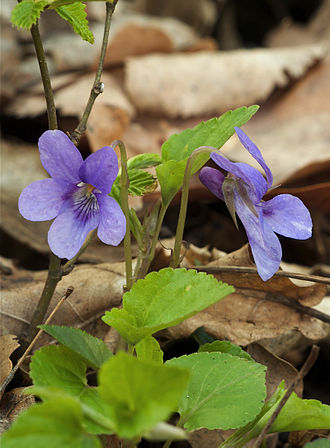Viola (plant)

Viola is a genus of flowering plants in the violet family Violaceae. It is the largest genus in the family, containing between 525 and 600 species. Most species are found in the temperate Northern Hemisphere; however, some are also found in widely divergent areas such as Hawaii, Australasia, and the Andes.
Some Viola species are perennial plants, some are annual plants, and a few are small shrubs. Many species, varieties and cultivars are grown in gardens for their ornamental flowers. In horticulture the term pansy is normally used for those multi-colored, large-flowered cultivars which are raised annually or biennially from seed and used extensively in bedding. The terms viola and violet are normally reserved for small-flowered annuals or perennials, including the wild species.
Annual or perennial caulescent or acaulescent (with or without a visible plant stem above the ground) herbs, shrubs or very rarely treelets. In acaulescent taxa the foliage and flowers appear to rise from the ground. The remainder have short stems with foliage and flowers produced in the axils of the leaves (axillary).[1]
Viola typically have heart-shaped or reniform (kidney-shaped), scalloped leaves, though a number have linear or palmate leaves.[1] The simple leaves of plants with either habit are arranged alternately; the acaulescent species produce basal rosettes. Plants always have leaves with stipules that are often leaf-like.
The flowers of the vast majority of the species are strongly zygomorphic with bilateral symmetry and solitary, but occasionally form cymes. The flowers are formed from five petals; four are upswept or fan-shaped with two per side, and there is one, broad, lobed lower petal pointing downward. This petal may be slightly or much shorter than the others and is weakly differentiated. The shape of the petals and placement defines many species, for example, some species have a “spur” on the end of each petal while most have a spur on the lower petal. The spur may vary from scarcely exserted (projecting) to very long, such as in Viola rostrata.[1]
Solitary flowers end long stalks with a pair of bracteoles. The flowers have five sepals that persist after blooming, and in some species the sepals enlarge after blooming. The corolla ranges from white to yellow, orange or various shades of blue and violet or multicolored, often blue and yellow, with or without a yellow throat.[1]
The flowers have five free stamens with short free filaments that are oppressed against the ovary, with a dorsal connective appendage that is large, entire and oblong to ovate. Only the lower two stamens are calcarate (possessing nectary spurs that are inserted on the lowest petal into the spur or a pouch). The styles are filiform (threadlike) or clavate (clubshaped), thickened at their tip, being globose to rostellate (beaked). The stigmas are head-like, narrowed or often beaked. The flowers have a superior ovary with one cell, which has three placentae, containing many ovules.[1]
After flowering, fruit capsules are produced that are thick walled, with few to many seeds per carpel, and dehisce (split open) by way of three valves.[2] On drying, the capsules may eject seeds with considerable force to distances of several meters.[3] The nutlike seeds, which are obovoid to globose, are typically arillate (with a specialized outgrowth) and have straight embryos, flat cotyledons, and soft fleshy endosperm that is oily.[4][1]
